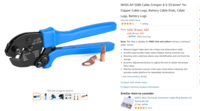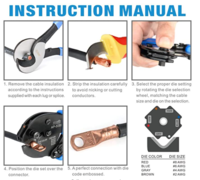next up is this beauty . . . my first port of call and go to large crimper.
it will crimp most large lugs and crimps . . . . if it fits on the gap . . . it will crimp it.
I've have some tough crimps before . . . and even with 15stone leaning down on it its not broke.
its big at 13 inches long.
this is the most used crimper for large cables.
i cant remember where i got it from now . . . but been using it a couple of years now.


next up . .
it will crimp most large lugs and crimps . . . . if it fits on the gap . . . it will crimp it.
I've have some tough crimps before . . . and even with 15stone leaning down on it its not broke.
its big at 13 inches long.
this is the most used crimper for large cables.
i cant remember where i got it from now . . . but been using it a couple of years now.


next up . .















